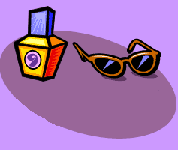An important part of any anti-aging skin care program is to know what you may be doing that is harming your skin and speeding up your skin's aging process.
Here are 7 habits that contribute to aging skin, making you look older than your years:
- Cigarette smoke: Whether you smoke, or you spend time with a smoker, cigarette smoke is damaging -- and aging --
to your skin. Research has shown that exposure to cigarette smoke significantly increases skin wrinkles and dryness. This
is partly due to the behavior of smoking, and also because cigarette smoke depletes your body of Vitamin C, which is a key ingredient for keeping skin plump and moist.
Some researchers believe that exposure to cigarette smoke (whether you smoke or not) is as damaging to aging skin as exposure to the sun's ultraviolet rays.
- Sun exposure: Sun exposure is very aging to skin. Unprotected skin that is exposed to the sun becomes more mottled
in appearance. Freckles can turn into brown sun spots, the skin takes on a dry, leathery appearance, and wrinkles and sagging
increase. The risk of skin cancer is significantly increased by sun exposure.
The good news is that sun damage is avoidable, and if you start now, you can improve the condition of sun damaged skin.
- See your health care provider to assess the amount of sun damage you may have, and to rule out possible skin cancers. He or she may be able to prescribe medication that can help to reduce existing sun damage.
- If you want to avoid aging skin but don’t want to avoid the sun, make sure you use sunscreen that protects against both UVA and UVB rays. Choose sunscreen with SPF of 15 or higher, and use it all year-round, even on cloudy days. Clouds do not protect you from ultraviolet ray exposure.
- Lack of exercise: Living a sedentary life contributes to aging skin, because exercise helps to tone your muscles
and get your blood flowing. Exercise should be an important part of every anti-aging skin care program. Researchers have also discovered that sedentary older adults are at higher risk for dementia .
In addition to the physical benefits of exercise, the benefits of a regular exercise program will show on your face. Having a bright smile and lots of energy will help you look and feel younger, at any age.
- Exposure to cold weather: Cold winds and low temperatures contribute to aging skin by making skin
dry, so if you venture out in the cold be sure to use a good moisturizer.
It’s important to use moisturizer indoors too, as heated rooms can be very drying to skin. Consider using a humidifier to help keep your skin more comfortable and reduce the aging skin effects of heated rooms.
- Alcohol use: Alcohol contributes to aging skin by dilating small blood vessels in the skin and increasing blood flow near the skin's surface. Over time, these blood vessels can become permanently damaged, creating a flushed appearance and broken vessels on the skin’s surface.
- Stress: Maybe you’ve heard this expression: “Don’t frown, your face could stay
that way.” Stress and worry cause frowning, and over time the muscles in the face actually conform to that movement.
To help reduce aging skin due to stress, be aware of your stress level and try to vary your facial expressions during the day. A good anti-aging skin care program should include meditation, yoga, gentle exercise or other relaxation techniques. Keeping stress in check -- and frown lines and aging skin wrinkles to a minimum -- will help you look and feel younger.
- Lack of sleep: Too little sleep makes you look and feel tired. One of the first places lack up sleep
shows up is on the face, with dark circles and bags under the eyes, and sagging skin. Lack of sleep is also a major factor
in memory loss and symptoms of depression that include low interest in daily activities and negative thinking.
Research has shown that most adults function best with 8-9 hours of sleep each night. Reduce caffeine during the day (with none in the evening), avoid eating at least 2 hours before bedtime, and maintain a sleep routine that includes going to bed at the same time each night. For more sleeping tips, see How to Get a Good Night's Sleep.
If you are having trouble sleeping, for any reason, it’s important to see your health care provider.
While some signs of aging skin are inevitable, there’s a lot you can do to look your best at any age. Taking good care of yourself is the most important step in your anti-aging skin care program.
2. Name 3 Primary skin lesions and 3 Secondary skin lesions.
http://en.wikipedia.org/wiki/Skin_lesion
3.Define the following:
Bulla Papule Pustule Keloid Scar Comedo Milia Acne Rosaccea Herpes simplex Psoriasis Albinism Tan
4. Watch video. Write a paragraph about video. http://www.medicinenet.com/script/main/art.asp?articlekey=123460
Hair Removal
5. Name 2 ways to permanently remove hair and how much does it cost?
http://www.ehow.com/way_5764688_inexpensive-permanent-hair-removal.html
6. Name ways to temporary remove hair
http://www.simplyhairremoval.com/Temporary-Hair-Removal-Methods.html
7. Write the steps to a facial
A facial cleans, exfoliates and nourishes the skin to promote clear, well-hydrated skin. A facial is the second most popular spa treatment after massage. It is sometimes called a "deep-cleansing facial" or or "deep-pore cleansing" facial because of extractions.
The Basic Steps of a Facial


